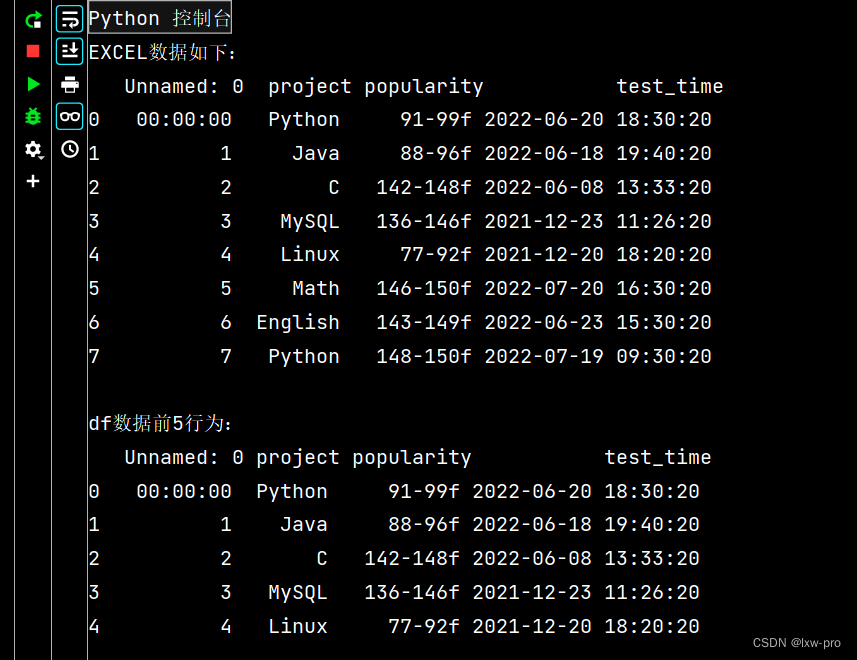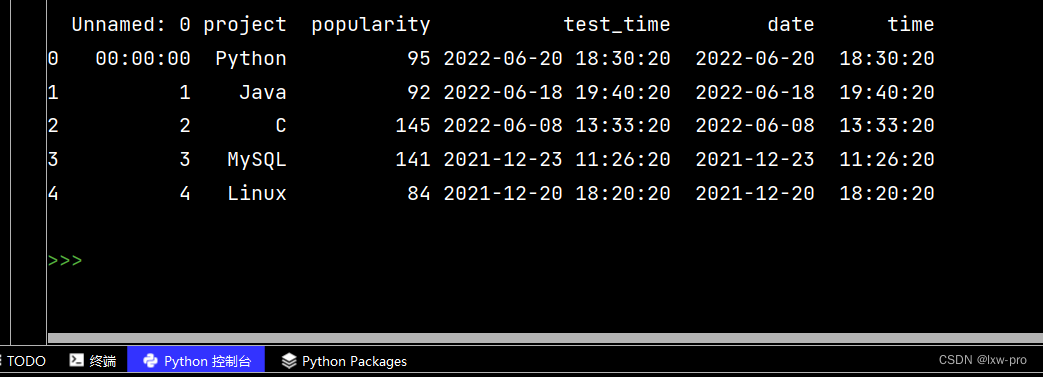# 注意时区的设置
import time
# 获得当前时间时间戳
now = int(time.time())
# 转换为其他日期格式,如:"%Y-%m-%d %H:%M:%S"
timeArr = time.localtime(now)
other_StyleTime = time.strftime("%Y-%m-%d %H:%M:%S", timeArr)
print(other_StyleTime)
import datetime
# 获得当前时间
now = datetime.datetime.now()
other_StyleTime = now.strftime("%Y-%m-%d %H:%M:%S")
print(other_StyleTime)
import datetime
def getYesterday():
today = datetime.date.today()
oneday = datetime.timedelta(days=1)
yesterday = today - oneday
return yesterday
print("昨天的日期:", getYesterday())
# 引入日历模块
import calendar
# 输入指定年月
yy = int(input("输入年份:"))
mm = int(input("输入月份:"))
# 显示指定年月
print(calendar.month(yy, mm))
运行效果如下:

import calendar monthRange = calendar.monthrange(2022, 4) print(monthRange)
import time
import datetime
# 先获得时间数组格式的日期
threeDayAgo = (datetime.datetime.now() - datetime.timedelta(days=3))
# 转换为时间戳
timeStamp = int(time.mktime(threeDayAgo.timetuple()))
# 转换为其他字符串格式
otherStyleTime = threeDayAgo.strftime("%Y-%m-%d %H:%M:%S")
print(otherStyleTime)
import time import datetime # 给定时间戳 timeStamp1 = 1643892140 dateArray = datetime.datetime.utcfromtimestamp(timeStamp1) threeDayAgo = dateArray - datetime.timedelta(days=3) print(threeDayAgo)
import time
timeStamp = 1825135462
timeArr = time.localtime(timeStamp)
other_StyleTime = time.strftime("%Y-%m-%d %H:%M:%S", timeArr)
print(other_StyleTime)
或
import datetime
timeStamp = 2022020321
dateArr = datetime.datetime.utcfromtimestamp(timeStamp)
other_StyleTime = dateArray.strftime("%Y-%m-%d %H:%M:%S")
print(other_StyleTime)
print()只为换行用,方便看运行结果
# -*- coding = utf-8 -*- # @Time : 2022/7/22 19:46 # @Author : lxw_pro # @File : pandas-5 练习.py # @Software : PyCharm import pandas as pd
df = pd.read_excel('test-5.xlsx')
print("EXCEL数据如下:\n", df)
print()
print("df数据前5行为:\n", df.head())
print()
import re
def func(df):
zfg = df['popularity'].split('-')
smin = int(zfg[0].strip('f'))
smax = int(zfg[1].strip('f'))
df['popularity'] = int((smin+smax)/2)
return df
df = df.apply(func, axis=1)
print(df)
print()
fzj = df.groupby('project').mean()
print("分组后的平均分为:\n", fzj)
print()
df['date'] = df['test_time'].dt.date
df['time'] = df['test_time'].dt.time
print(df.head())
df.to_excel('text5.xlsx') # 也可将所运行的结果导入另一个新的EXCEL
相关程序运行结果如下:
21-22:

23-24:
25:

存入的新EXCEL数据:
